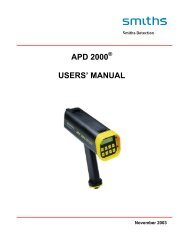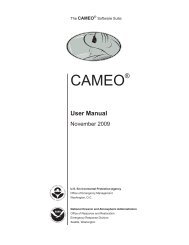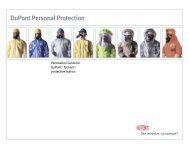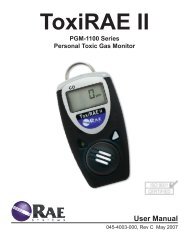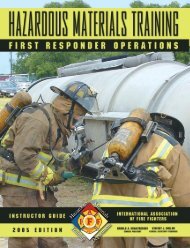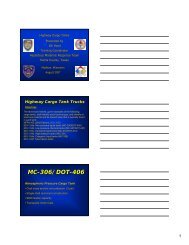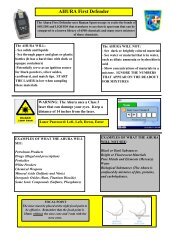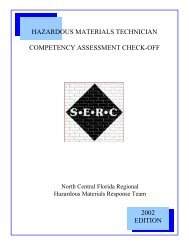Handheld Raman (first defender) - Livonia Professional Firefighters
Handheld Raman (first defender) - Livonia Professional Firefighters
Handheld Raman (first defender) - Livonia Professional Firefighters
Create successful ePaper yourself
Turn your PDF publications into a flip-book with our unique Google optimized e-Paper software.
Notable Fluorescence ConsiderationsFluorescence was found to thwart <strong>Raman</strong> identification in some samples by either saturating the detectorso that data could not be processed (Semtex 1A, Pentolite, Comp B), or because the system estimated aprohibitively long scan time of several minutes up to an hour that was deemed not acceptable for field use.Fluorescence during <strong>Raman</strong> analysis was found to be somewhat predictable based on sample color; white orcolorless samples generally did not exhibit fluorescence, and “natural” tan or brightly colored samples didgenerally exhibit fluorescence.Notable Dark Colored Sample ConsiderationsSample color also affects <strong>Raman</strong> analysis because of potential sample heating due to laser absorption. In thecase of green DetaSheet, a PETN-based plastic explosive, the samples occasionally smoked due to sampleheating; pink samples containing PETN were readily identified. One should consider sample color carefully insuch an analysis, as a dark colored and more sensitive explosive, e.g., black powder, could be initiated. AhuraScientific recommends segregating small samples for analysis to limit any safety issues associated with coloredsamples. Furthermore, FirstDefender is available with a scan delay feature that will not engage the laser for aset delay period to allow an investigator to leave the scene during analysis. The one meter FlexProbe can alsobe used to increase the distance between the analyst/instrument and the sample for safety purposes.Notable Oxidizer Sample ConsiderationsFirstDefender performed exceptionally well in identifying single oxidizer samples of ammonium perchlorate,sodium nitrate, ammonium nitrate, potassium chlorate and some mixtures of these common oxidizers used inthe manufacture of low and high explosives. However, in one case a mixture of sodium nitrate and potassiumnitrate was misidentified as only being sodium nitrate. This was calculated as a “no match found,” but was laterreanalyzed after a more through mixing, which correctly identified both constituents.Notable Mixture Analysis Results DiscussionIt was found in screening solid or semisolid mixtures (dynamite and emulsion) that the small laser spot size ofFirstDefender may sample one component of the mixture and not another if the grain size of the materials isnot large enough to be registered, or if the substance was not mixed properly . Other hastily, onsite sampleswere mixed and provided similar results; a “miss” followed by correct analysis following a thorough mixing.As stated previously, this is an issue with the very narrow laser beam of the instrument and turning the vial sothat multiple spots are sampled during measurements through the vial may also be used to randomize the<strong>Raman</strong> sampling.Performance of a <strong>Handheld</strong> <strong>Raman</strong> Spectrometer for Explosives Identification May 200911



